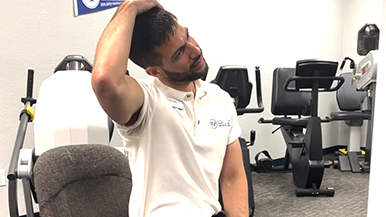- What is plantar fasciitis?
- What does plantar fasciitis feel like?
- What causes plantar fasciitis?
- What is the best treatment for plantar fasciitis?
- How can physical therapy help my plantar fasciitis?
For the more than 2 million people struggling with plantar fasciitis in the U.S. each year, the pain can be debilitating. Fortunately, plantar fasciitis can be treated noninvasively in many cases, meaning you don’t need to have surgery to experience relief. Here’s what you need to know about the best treatment for plantar fasciitis.

What is Plantar Fasciitis?
Plantar fasciitis occurs when the band of tissue that runs along the bottom of your foot becomes irritated and inflamed. Directly under the skin on the arch of your foot is a thin ligament called the plantar fascia. It serves an important purpose, connecting the heel to the front of your foot and supporting the arch that lies there.
The human foot is incredibly complex, with 26 bones, 33 movable joints, and 107 ligaments, 19 muscles and tendons holding everything in place. Your foot may seem small when compared to the rest of your body, but it makes up 25% of all the bones under your skin. Imagine the force that comes down on your foot each day as you conduct your normal activities of walking, running, playing sports, and more. It’s no wonder that the American Podiatric Medical Association (APMA) reports 77% of Americans suffer from some form of foot pain.
While there are many types of ailments that can affect your poor feet, if you have plantar fasciitis you will certainly know it. The pain of this disorder can be debilitating.
What Does Plantar Fasciitis Feel Like?
Excruciating is one word to describe the pain of plantar fasciitis. Imagine getting out of bed in the morning and putting weight on the bottom of your foot. Immediately an intense deep pain radiates upward from your heels. Plantar fasciitis has been described as making your feet feel like one big bruise. Even your own body weight can cause considerable discomfort.
What Causes Plantar Fasciitis?
The inflammation that comes with plantar fasciitis can be caused by a number of behavioral and anatomical factors. For example:
Behavioral causes of plantar fasciitis:
- Certain types of exercise like running or running barefoot
- Occupations that require long periods of standing and walking
- Wearing improper footwear
Anatomical causes of plantar fasciitis:
- Aging
- Flat feet
- High arches
- Leg length discrepancy
- Obesity
- Shortened Achilles tendon
- Weak muscles
What is The Best Treatment for Plantar Fasciitis?
The best treatment for plantar fasciitis could simply be icing and resting your feet. Or, you may need physical therapy to help the foot heel. A steroid injection may also help. Determining the best course of treatment for plantar fasciitis first requires that you see your doctor to diagnose the problem.
Harvard Medical School says many plantar fasciitis cases improve with home-based treatment. However, these treatments can take weeks or months to take hold. During this time your doctor may counsel you to avoid some of the activities that caused the plantar fascia to flame up. So, no basketball or running for a few weeks. It’s also possible your shoes caused the problem; 14% of patients say their symptoms improved just by changing their shoes.
At the same time, you don’t want to stop exercising entirely because the plantar fascia muscle can stiffen up and make things worse. So, see your doctor, who will conduct a few steps to determine if plantar fasciitis is what’s causing your pain. This could include:
- An examination to determine where the pain is coming from
- Imaging tests such as X-rays can look for fractures in the delicate bones of your foot
The American Academy of Orthopaedic Surgeons (AAOS) says more than 90% of patients diagnosed with plantar fasciitis will improve by using simple treatment methods within 10-months of their diagnosis. In these cases, your doctor may prescribe:
- Foot massages to soothe the inflammation
- Icing your foot for 20-minutes three or four times a day
- Over-the-counter anti-inflammatories such as ibuprofen or naproxen to lessen pain
- Resting the feet by stopping anything that makes the pain worse
- Specific stretches to loosen the calf muscles and the plantar fascia
If these treatments don’t give you relief, your doctor may step up treatments in the following ways:
- A cortisone injection in the bottom of your foot can reduce inflammation and pain
- Night splints can stretch the plantar fascia
- Supportive shoes or custom orthotics can reduce the pain of standing and walking
Your doctor also may order physical therapy to cure your plantar fasciitis heal and get you back on your feet.
How Can Physical Therapy Help My Plantar Fasciitis?
Physical therapists, like those at Ability Rehabilitation, can evaluate your plantar fasciitis and treat it in most cases. Some of the techniques used include:
- An assessment of how you’re currently walking to see if that’s impacting your symptoms
- Orthotics, or shoe inserts to help support your arches and lessen the stress on the bottom of your foot
- Stretching exercises to improve your overall flexibility in the calf, Achilles tendon, plantar fascia, and ankle
- Strengthening exercises to improve the supporting muscles around the plantar fascia
- Taping the feet to give you some short-term pain relief
- Teaching you warm-up techniques before exercise that lessens the strain on your plantar fascia
While these are just a few of the common techniques used by physical therapists, these clinical professionals have extensive training in body mechanics. They will be able to see how your body coordinates the mechanics of walking and running and spot issues that may be the underlying cause of the plantar fasciitis.
For example, a leg length discrepancy, more commonly known as a short leg could cause you to move more awkwardly than you should. Foot and ankle weakness and limited range of motion could also contribute to a painful bout of plantar fasciitis. Your physical therapist can even recommend better shoes to make sure you never experience the pain of plantar fasciitis again.



